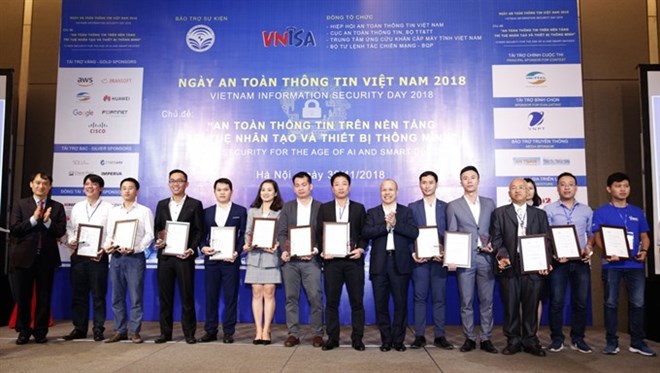Viet Nam's Information Security Index revealed
The 2018 Information Security Index of Viet Nam was 45.6%, a figure at average level, reported by Viet Nam Information Security Association (VNISA) in Ha Noi on November 30.
 |
| The 2018 Information Security Index of Vietnam was 45.6 percent, a figure at average level, reported by Vietnam Information Security Association (VNISA) in Hanoi on November 30.(Source: cmc.com.vn) |
Data from VNISA revealed the country’s information security indices were 47.4%, 59.9%, and 46.8% respectively in 2015, 2016 and 2017.
The 2018 Viet Nam Information Security Day conference under the theme “Cyber security for the age of artificial intelligence and smart devices” was hosted by the VNISA, in collaboration with the Authority of Information Security and the Viet Nam Computer Emergency Response Team under the Ministry of Information and Communications, and the Command 86 under the Ministry of Defence.
Viet Nam has about 350,000 IoT (Internet of Things) devices on the Internet, most of which are cameras and routers. More than 40 percent of those might be affected by information security loopholes, said Nguyen Thanh Hung, Deputy Minister of information and communications.
Speaking at the conference, Hung said in the future, artificial intelligence (AI) and IoT would be two concepts which are always mentioned together.
"IoT generates huge amounts of data and AI helps analyse and process it."
Even though IoT promoted the digitisation of many industries, it posed security threats to new technology applications, he said.
Tools used to attack IoT devices were becoming more sophisticated, algorithms used to attack and artificial intelligence (AI) would be increased in the level of both attack and defence.
On the other hand, some of the terminal devices would become new targets, including refrigerators, robot vacuum cleaner, street lights or watches.
According to Gartner’s report, more than 25% of the attacks are from IoT-related companies by 2020.
"It is possible to see the risks in the coming time, in which malicious code will become smarter and the perfect environment for them is the network of IoT devices," said Hung.
This would be a great challenge that State agencies, organisations, businesses and the community in Viet Nam must pay attention to in order to avoid unexpected consequences, he said.
The Deputy Minister also noted that cyber security was a long-lasting war.
However, he also noted information security was a field that Viet Nam could make strides in comparison with other areas of science and technology.
Basically, information security was based on human resources, not too dependent on infrastructure.
One of the ways to enhance information security in Viet Nam was to create stronger trust among the society, he said. Trust was the key to success in the field of cyber security.
To promote the work to ensure cyber security, the deputy minister suggested State agencies and social organisations pay more attention to the work, regularly updating knowledge and new technologies, while technical systems must ensure information safety and meet the conditions for preventing and combating network attacks.
(Source: VNS/VNA/ DA NANG Today)